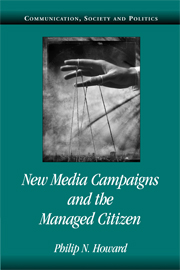Book contents
- Frontmatter
- Contents
- List of Tables and Figures
- Acknowledgments
- Prologue: The Flows of Information in Competitive Politics
- Introduction: The Hypermedia Campaign
- 1 Political Communication and Information Technology
- 2 Producing the Hypermedia Campaign
- 3 Learning Politics from the Hypermedia Campaign
- 4 Organizational Communication in the Hypermedia Campaign
- 5 Managed Citizenship and Information Technology
- Appendix: Method Notes on Studying Information Technology and Political Communication
- Glossary
- References
- Index
- Titles in the series
3 - Learning Politics from the Hypermedia Campaign
Published online by Cambridge University Press: 15 December 2009
- Frontmatter
- Contents
- List of Tables and Figures
- Acknowledgments
- Prologue: The Flows of Information in Competitive Politics
- Introduction: The Hypermedia Campaign
- 1 Political Communication and Information Technology
- 2 Producing the Hypermedia Campaign
- 3 Learning Politics from the Hypermedia Campaign
- 4 Organizational Communication in the Hypermedia Campaign
- 5 Managed Citizenship and Information Technology
- Appendix: Method Notes on Studying Information Technology and Political Communication
- Glossary
- References
- Index
- Titles in the series
Summary
Politics is what happens when one person tries to represent another person's interests. E-politics is what happens when one person uses a good technology to project their own interests into the right places.
– Morris, chief operations officer, GrassrootsActivist.orgWhat happens to the public sphere if nobody goes out in public?
– Dania, marketing director, Voting.comTechnological innovations can radically alter the organization of power in politics, and it is almost impossible to distinguish political systems from their communication technologies. Whereas the previous chapter concerned how hypermedia are used in producing political campaigns, this chapter deals with how political communication is consumed through hypermedia. I describe the work of Voting.com and GrassrootsActivist.org, pseudonyms for two organizations that specialize in helping citizens consume political information. Building on ethnographic evidence, I argue that political hypermedia have been designed to open up the market for political information about both citizens and campaigns. This open market, however, has immense implications for the way we consume political content. I conclude by describing the process of political redlining, which occurs when citizens use hypermedia deliberately to construct their informational networks or when campaigns use hypermedia to contextualize the information they provide to a purposefully structured public.
In 1922, Lippmann published Public Opinion, a foundational text for political science. Lippmann attempted to reconcile the Jeffersonian gospel of devout citizen engagement with the practical challenges of having voters sophisticated enough to actually contribute to complex decision-making processes on a wide variety of issues.
- Type
- Chapter
- Information
- New Media Campaigns and the Managed Citizen , pp. 101 - 142Publisher: Cambridge University PressPrint publication year: 2005



